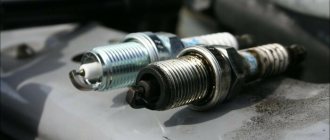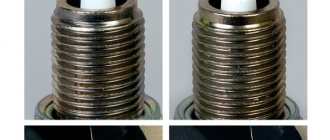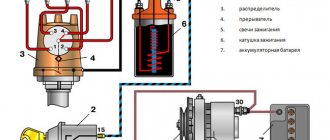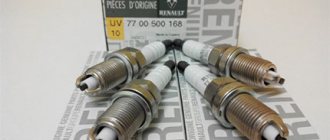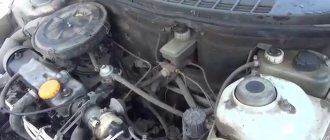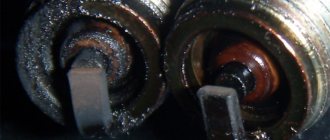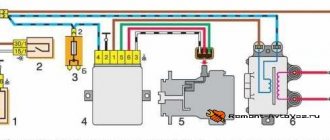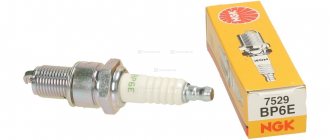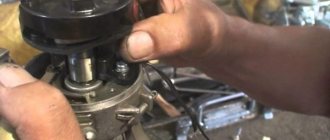Diagnostics of engine operation based on the condition of spark plugs
Photo No. 1 shows a spark plug removed from an engine whose performance can be considered excellent. The skirt of the central electrode is light brown in color, soot and deposits are minimal. Complete absence of oil traces. The owner of this engine can only be envied, and there is something to be said for its economical fuel consumption and the absence of the need to add oil from replacement to replacement.
Photo No. 2 shows a typical example of a spark plug from an engine with high fuel consumption. The central electrode is covered with velvety black soot. There are several reasons for this: a rich air-fuel mixture (incorrect carburetor adjustment or injector malfunction), clogged air filter.
The third photo, on the contrary, is an example of an excessively lean air-fuel mixture. The color of the electrode is from light gray to white. There is cause for concern here. Driving with a too lean mixture and under increased loads can cause significant overheating of both the spark plug itself and the combustion chamber, and overheating of the combustion chamber is a direct path to burnout of the exhaust valves. Skirt of the central electrode of the spark plug shown in the photo
№4 has a characteristic reddish tint, this color can be compared to the color of red brick. This redness is caused by the engine running on fuel containing an excessive amount of metal additives. Long-term use of such fuel will cause metal deposits to form a conductive coating on the insulation surface, through which it will be easier for current to pass than between the electrodes of the spark plug, and the spark plug will stop working.
Photo No. 5. The candle has pronounced traces of oil, especially in the threaded part. An engine with such spark plugs after a long period of parking tends to “triple” for some time after starting, and as it warms up the operation stabilizes. The reason for this is the unsatisfactory condition of the oil seals. There is increased oil consumption. In the first minutes of engine operation, at the moment of warming up, there is a characteristic white and blue exhaust.
The spark plug in photo No. 6 was removed from a non-functioning cylinder. The central electrode and its skirt are covered with a dense layer of oil mixed with drops of unburnt fuel and small particles from the destruction that occurred in this cylinder. The reason for this is the destruction of one of the valves or the breakage of the partitions between the piston rings with metal particles getting between the valve and its seat. In this case, the engine “troubles” incessantly, a significant loss of power is noticeable, fuel consumption increases by one and a half, two times. There is only one way out - repair.
Photo No. 7 is a complete destruction of the central electrode with its ceramic skirt. The cause of this destruction could be one of the following factors: prolonged operation of the engine with detonation, the use of low octane fuel, very early ignition, and simply a defective spark plug. The engine operating symptoms are the same as in the previous case. The only thing you can hope for is that the particles of the central electrode managed to slip into the exhaust system without getting stuck under the exhaust valve, otherwise repairing the cylinder head cannot be avoided. But it depends on the person, whether he is sinful or not (just kidding). If we talk about this particular candle, then God had mercy on its owner.
Photo No. 8 is the last one in this review. The spark plug electrode is overgrown with ash deposits; the color does not play a decisive role, it only indicates the operation of the fuel system. The reason for this build-up is the combustion of oil due to wear out or jamming of the oil scraper piston rings. The engine has increased oil consumption, when over-gasping, there is strong blue smoke from the exhaust pipe, and the smell of the exhaust is similar to that of a motorcycle. If you want to have fewer problems with the operation of your engine, do not think about spark plugs only when the engine refuses to work. The manufacturer guarantees trouble-free operation of the spark plug on a working engine for 30 thousand kilometers. But you, in turn, do not forget to check the condition of the spark plugs with every oil change or on average every 10 thousand kilometers. First of all, this is adjusting the gap to the required value and removing carbon deposits. It is better to remove carbon deposits with a metal brush; sandblasting destroys the ceramics of the central electrode, and you risk getting a copy of photo No. 7. I would also recommend swapping spark plugs, this is due to different temperature conditions of the cylinders.
1. Normal spark plug Brown or grayish-yellowish color and slight wear on the electrodes. Exact matching of the spark plug thermal value for the engine and operating conditions.
HELPFUL ADVICE! When replacing spark plugs with new ones, install spark plugs with the same characteristics recommended by the manufacturer.
2. Soot deposits
Dry soot deposits indicate a rich air/fuel mixture or late ignition. Causes misfire, difficult engine starting and unstable engine operation. Check if the air filter is clogged and if the coolant and intake air temperature sensors are working properly.
HELPFUL ADVICE! Use a hotter candle.
3. Oil deposits Oily electrodes and spark plug insulator. The reason is oil entering the combustion chamber. Oil enters the combustion chamber through valve guides or rings. Causes difficult starting, cylinder misfires and “twitching” of a melting engine. The cylinder head and piston engine need to be repaired. Replace spark plugs.
4. Metal-containing deposits Deposits on the insulator skirt of iron oxides of brick-red color from anti-knock iron-containing additives (ferrocenes) to gasoline. They are deposited in an even, dense layer. When the engine operates under heavy load under the influence of high temperature and pressure in the combustion chamber, the oxides are reduced into conductive tracks of pure iron, which close the central electrode to ground. This causes misfires and, as a result, a drop in engine power and increased fuel consumption. In addition, the catalytic converter of the exhaust gases may be damaged, overheating greatly when unburned gasoline enters the engine cylinders. The plaque is practically not removed mechanically and does not fade during prolonged movement at high speed. If this deposit appears on new spark plugs after a short mileage, change the refueling location.
HELPFUL ADVICE! If it is not possible to immediately replace the spark plugs with new ones, try removing this deposit by immersing the spark plugs for ten minutes in orthophosphoric acid or a rust converter (contains phosphoric acid). After this, clean the deposits with a non-metallic brush (or an old toothbrush) and rinse the spark plugs, first with water and then with gasoline.
5. Early ignition Melted electrodes. The insulator is white, but may be contaminated due to misfires and combustion chamber deposits. May cause engine damage. It is necessary to check the suitability of the spark plug type, the cleanliness of the injector nozzles and fuel filter, and the operation of the cooling and lubrication systems.
6. Detonation The insulator may be cracked or chipped. This may damage the piston. Make sure that the octane number of gasoline matches the required one.
7. Mechanical damage Damage can be caused by foreign objects getting into the combustion chamber, and if a spark plug is too long, its electrodes may catch on the piston. This causes spark plug destruction, cylinder shutdown and can damage the piston. Remove the foreign object from the cylinder and/or replace the spark plug.
pensia › Blog › Diagnostics of engine operation based on the condition of the spark plugs.
Spark plugs, these simple-looking compounds of metal and ceramic, are the most important element in the operation of an engine. Even by the appearance of the spark plug you can tell a lot, both about the operation of the engine as a whole and about its individual components. Inspection of the spark plug should be carried out after prolonged operation of the engine; the ideal option would be to inspect the spark plug after a long trip on a country highway.
Photo No. 1 shows a spark plug removed from an engine whose performance can be considered excellent. The skirt of the central electrode is light brown in color, soot and deposits are minimal. Complete absence of oil traces. The owner of this engine can only be envied, and there is something to be said for its economical fuel consumption and the absence of the need to add oil from replacement to replacement.
Photo No. 2 shows a typical example of a spark plug from an engine with high fuel consumption. The central electrode is covered with velvety black soot. There are several reasons for this: a rich air-fuel mixture (incorrect carburetor adjustment or injector malfunction), clogged air filter.
The third photo, on the contrary, is an example of an excessively lean air-fuel mixture. The color of the electrode is from light gray to white. There is cause for concern here. Driving with a too lean mixture and under increased loads can cause significant overheating of both the spark plug itself and the combustion chamber, and overheating of the combustion chamber is a direct path to burnout of the exhaust valves. Skirt of the central electrode of the spark plug shown in the photo
No. 4 has a characteristic reddish tint, this color can be compared to the color of red brick. This redness is caused by the engine running on fuel containing an excessive amount of metal additives. Long-term use of such fuel will cause metal deposits to form a conductive coating on the insulation surface, through which it will be easier for current to pass than between the electrodes of the spark plug, and the spark plug will stop working.
Photo No. 5. The candle has pronounced traces of oil, especially in the threaded part. An engine with such spark plugs after a long period of parking tends to “triple” for some time after starting, and as it warms up the operation stabilizes. The reason for this is the unsatisfactory condition of the oil seals. There is increased oil consumption. In the first minutes of engine operation, at the moment of warming up, there is a characteristic white and blue exhaust.
The spark plug in photo No. 6 was removed from a non-functioning cylinder. The central electrode and its skirt are covered with a dense layer of oil mixed with drops of unburnt fuel and small particles from the destruction that occurred in this cylinder. The reason for this is the destruction of one of the valves or the breakage of the partitions between the piston rings with metal particles getting between the valve and its seat. In this case, the engine “troubles” incessantly, a significant loss of power is noticeable, fuel consumption increases by one and a half, two times. There is only one way out - repair.
Photo No. 7 is a complete destruction of the central electrode with its ceramic skirt. The cause of this destruction could be one of the following factors: prolonged operation of the engine with detonation, the use of low octane fuel, very early ignition, and simply a defective spark plug. The engine operating symptoms are the same as in the previous case. The only thing you can hope for is that the particles of the central electrode managed to slip into the exhaust system without getting stuck under the exhaust valve, otherwise repairing the cylinder head cannot be avoided. But it depends on the person, whether he is sinful or not (just kidding). If we talk about this particular candle, then God had mercy on its owner.
This is interesting: How to keep a car if there is no garage?
Photo No. 8 is the last one in this review. The spark plug electrode is overgrown with ash deposits; the color does not play a decisive role, it only indicates the operation of the fuel system. The reason for this build-up is the combustion of oil due to wear out or jamming of the oil scraper piston rings. The engine has increased oil consumption, when over-gasping, there is strong blue smoke from the exhaust pipe, and the smell of the exhaust is similar to that of a motorcycle. If you want to have fewer problems with the operation of your engine, do not think about spark plugs only when the engine refuses to work. The manufacturer guarantees trouble-free operation of the spark plug on a working engine for 30 thousand kilometers. But you, in turn, do not forget to check the condition of the spark plugs with every oil change or on average every 10 thousand kilometers. First of all, this is adjusting the gap to the required value and removing carbon deposits. It is better to remove carbon deposits with a metal brush; sandblasting destroys the ceramics of the central electrode, and you risk getting a copy of photo No. 7. I would also recommend swapping spark plugs, this is due to different temperature conditions of the cylinders.
Brick candle
When diagnosing an engine using spark plugs, you can also see a red part. Typically, such deposits accumulate on the skirt of the central electrode. Such a spark plug does not indicate a malfunction in the engine. The presence of red carbon deposits tells the car owner that it is time to change the gas station. This deposit occurs due to low-quality fuel, which contains metal-containing additives.
If you drive this kind of gasoline regularly, then a layer of deposits will form that can conduct electricity. And the spark, which should jump between the electrodes, will strike in a different place. The candle will simply fail and can only be thrown away. Fuel with a high content of such additives may eventually damage the ECU, as well as the lambda probe and catalyst.
Los4inin › Blog › Diagnostics of internal combustion engines based on the condition of spark plugs
Spark plugs, these simple-looking metal and ceramic connections, are a critical element in engine performance. Even by the appearance of the spark plug, you can tell a lot about both the operation of the engine as a whole and its individual components.
Inspection of the spark plug should be carried out after prolonged operation of the engine; the ideal option would be to inspect the spark plug after a long trip on a country highway. The mistake of some car enthusiasts, for example, is that after a cold start of the engine at sub-zero temperatures and its unstable operation, the first thing they do is unscrew the spark plugs and when they see black carbon deposits, they draw hasty conclusions. But this carbon deposit could form during engine operation in cold start mode, when the mixture is forcibly enriched, and unstable operation could be a consequence of, say, the poor condition of high-voltage wires.
Photo No. 2 shows a typical example of a spark plug from an engine with high fuel consumption. The central electrode is covered with velvety black soot. There are several reasons for this: a rich air-fuel mixture (incorrect carburetor adjustment or injector malfunction), clogged air filter.
Running an engine on leaded gasoline results in the formation of conductive, yellowish-brown deposits, which also reduce the likelihood of a spark forming at the spark plug. At room temperature, the presence of conductive deposits is not detected by instruments (ohmmeter).
The spark plug in photo No. 6 was removed from a non-functioning cylinder. The central electrode and its skirt are covered with a dense layer of oil mixed with drops of unburnt fuel and small particles from the destruction that occurred in this cylinder. The reason for this is the destruction of one of the valves or the breakage of the partitions between the piston rings with metal particles getting between the valve and its seat. In this case, the engine “troubles” incessantly, a significant loss of power is noticeable, fuel consumption increases by one and a half, two times. There is only one way out - repair.
Photo No. 8 The spark plug electrode is overgrown with ash deposits, the color does not play a decisive role, it only indicates the operation of the fuel system. The reason for this build-up is oil combustion due to depletion or obstruction of the oil scraper piston rings and the unsatisfactory condition of the oil seals. The engine has increased oil consumption, when over-gasping, there is strong blue smoke from the exhaust pipe, and the exhaust smell is similar to that of a motorcycle.
Photo No. 9 Destruction of a ceramic insulator. Causes of occurrence: a sharp change in temperature, for example when a spark plug removed from a hot engine is cooled in cold water. In some cases, destruction may be caused by a defect in the candle itself (defective or counterfeit), or by mechanical damage, for example as a result of a fall.
Signs of electrode erosion: the engine performs poorly, runs unstably even after warming up, misfires, and does not develop the required power.
Photo No. 11 Spraying a candle with gasoline. Often occurs due to a malfunction of the ignition system or carburetor / injector (flow). In winter, this can occur due to the fact that gasoline entering the combustion chamber does not have time to evaporate and settles on the spark plugs and cylinder walls. The solution is to unscrew the spark plugs and wash them with alcohol and let them dry or blow them with air. If you want to have fewer problems with the operation of your engine, do not think about spark plugs only when the engine refuses to work. The manufacturer guarantees trouble-free operation of the spark plug on a working engine for 30 thousand kilometers. But you, in turn, do not forget to check the condition of the spark plugs with every oil change or on average every 10 thousand kilometers. First of all, this is adjusting the gap to the required value and removing carbon deposits. It is better to remove carbon deposits with a metal brush; sandblasting destroys the ceramics of the central electrode, and you risk getting a copy of photo No. 7.
It is recommended to periodically change spark plugs, this is due to different temperature conditions of the cylinders.
Candles in oil
In used engines, engine diagnostics using spark plugs can help identify problems with increased oil appetite. Oil on a spark plug can often be found on the threads. It is mixed with black soot or deposits of any color. During a cold start, such engines can stall until they warm up, and then the engine operation stabilizes. The engine may also smoke. After warming up, the smoke will stop. Such an engine necessarily has increased oil consumption.
If there are abundant thick black-gray deposits on the spark plug, then not only a mixture of fuel and air is burning in the cylinders, but also oil. It will get into the cylinders due to worn oil scraper wheels. If there are problems with the rings, the engine will emit bluish smoke if you press the gas sharply. During transient operation of the internal combustion engine, a distinct smell of burnt oil will be felt.
How to check spark plugs
Signs of contamination or failure of spark plugs appear in the form of interruptions in engine operation; an engine with dirty or problematic spark plugs will suffer. This happens because all the candles usually do not fail at once. Interruptions begin in only one or two cylinders. The first step is to identify the spark plug that has failed. There are several ways to check spark plugs:
- using a device or tester to check spark plugs;
- independent checking of spark plugs;
To check the spark plugs, you need to remove them, although there are also ways to diagnose spark plugs on a car. Before starting the procedure that involves removal, you should turn off the ignition and prepare a special spark plug or socket wrench. You will need a tool to unscrew the spark plugs. Then you need to inspect the high-voltage armored ignition wires. These wires usually have special markings that contain information about the cylinder number. If there is no such marking, you will need to mark the high-voltage spark plug wires yourself in an accessible way.
The next step is to remove the tips (caps) from the spark plugs. Please note that you should not pull on the high-voltage wire while performing this procedure, as this may damage the armor wire. To remove it, you need to hold onto the tip itself. After removing the spark plug caps, you can unscrew the spark plugs using a wrench. V-twin engines will require a long drive wrench, similar to a torque wrench. An extended collar will also work.
During removal, you should remember which cylinder each unscrewed spark plug corresponds to, since further inspection will allow you to determine possible malfunctions not only of the spark plugs, but also of the engine based on the condition of the spark plugs. Checking the spark plugs should begin with a visual inspection and checking the condition of the insulator, as well as the electrodes. Cracks or melting, as well as other noticeable defects, are not allowed. Next, the candles are installed on a special stand or checked with a device. As mentioned above, motorists also check the spark plug directly on the car or use a multimeter. We will talk about various verification methods below.
Black soot
If, during the diagnosis of spark plugs by carbon deposits, a “fluffy” black deposit was found on the electrode, this indicates the following problems. The engine runs on an over-enriched fuel-air mixture and consumes more fuel than necessary. This happens due to an incorrectly configured carburetor (on old cars), or due to problems with the injector.
Experts also recommend paying attention to the exhaust system, since it is the lack of air that can cause the mixture to become richer. The reason for this is simple – a dirty air filter. It is recommended to change it no later than after 20 thousand kilometers
If the machine is operated in a polluted area, it is better to reduce this interval to 10 thousand
It is recommended to change it no later than after 20 thousand kilometers. If the machine is operated in a polluted area, it is better to reduce this interval to 10 thousand.
Checking spark plugs for spark
To check the spark plug for a spark, you need to disconnect the high-voltage wires that connect the spark plugs and the distributor breaker one by one. This must be done with the car running. After removing the wire, listen to the engine. If the operation of the motor has not changed, then this means that it was possible to find the failed element. If, after disconnection, the motor begins to operate even less stably, the test must be continued.
The next way to check the spark on the spark plugs is to remove the high-voltage wire, after which the spark plug is unscrewed. Then the spark plug is inserted back into the armored wire cap and brought to the cylinder block. As a result, a clearly visible spark should appear on the spark plug, which will be accompanied by a characteristic crackling sound. This method allows you to diagnose the operation of the ignition system, wire and spark plug.
Let us add that it is more correct to check the high-voltage ignition wires with a multimeter. This device is capable of measuring the resistance of the wire, after which it should be compared with the nominal one. A drop in voltage will indicate the need to replace the armor wire.
Another way is to check the spark plugs with a “gun”. Such a “gun” for checking candles is a testing stand that is available from candle sellers. This equipment allows you to test spark plugs under pressure, that is, their operating conditions in the engine are partially simulated.
Checking the spark plug on the stand is carried out as follows:
- the spark plug is inserted into the groove;
- then a special cap is put on it;
- then all that remains is to pull the trigger of the “gun” to check the spark plugs;
The appearance of a spark on the electrodes and the lighting of the warning light most likely indicates the serviceability of the spark plug, although this test method cannot guarantee full functionality. The fact is that the pressure on the stand and in the engine is different. For this reason, a spark plug previously tested on a bench with a good spark may still not work after being installed on the engine. If the spark plug initially does not work on the stand, then this element should be replaced due to an obvious malfunction.
How to clean the spark plugs yourself and set the gap between the electrodes
After removal and external inspection, the spark plug must be carefully cleaned of dirt, soot, carbon deposits and deposits. This can be done mechanically, using a brush that has medium-hard bristles. It is also possible to use an abrasive.
The mechanical method allows you to efficiently remove carbon deposits, but the performance characteristics of the spark plug usually become worse. This type of cleaning usually results in scratches, which then cause the spark plug to overheat. For this reason, it is necessary to clean spark plugs from deposits as delicately as possible.
You can also clean spark plugs chemically:
- the candle is degreased and washed in gasoline;
- then the candles are dried for 30 to 60 minutes;
- then the candles are placed in a solution of ammonium acetate for 30-40 minutes;
The advantage is a reduced risk of mechanical damage. The completion of cleaning is to check the gap between the electrodes of the spark plugs. The gap between the spark plug electrodes is assessed after mechanical cleaning.
The gap normally should not differ from the 0.7 mm mark. The specified gap must be checked using a special feeler gauge. If the gap is different, it needs to be adjusted. Adjusting the spark plug gap is performed with a special tool, and the process itself involves bending or bending the side electrode from the central electrode. Let us add that bending the central electrode is prohibited, and bending the side electrode should be done with extreme caution.
This is interesting: The trimmer does not start when hot
Engine condition by spark plug color
The serviceability of the engine and spark plugs is determined by the color of the deposit that is present on the electrodes. We will not describe all possible options for diagnosing the engine condition by the color of the spark plugs, since this is the topic of a large separate article. We only note that a working spark plug normally has a light grayish-brown coating.
The appearance of black dry soot on the electrode indicates the need to check the fuel system of the internal combustion engine. Such deposits form when the engine operates on a highly enriched mixture. The spark plug can then be cleaned and screwed back into the engine for further use.
Installing cleaned or new spark plugs into the engine at the initial stage is done by hand. In other words, the candles need to be “baited” by hand, that is, carefully screwed into the candle wells without using a key. If the spark plug is easily screwed into the thread, then the element can be tightened with a wrench until the conical part comes into contact with the cylinder head.
Remember, when tightening the spark plugs, it is highly advisable to strictly adhere to the tightening torque specified in the technical documentation for a specific engine type! Retightening the spark plug may lead to the need for subsequent repair of the cylinder head and other consequences. As for loosely twisted spark plugs, an under-tightened spark plug can cause engine malfunctions.
Tips and tricks
If new spark plugs quickly change color after installation, become overgrown with carbon deposits and again cause engine malfunctions, then the following options are possible:
- spark plugs are incorrectly selected;
- a counterfeit or defective product was purchased;
- the engine is operated on low quality gasoline or oil;
- there are engine malfunctions that quickly disable new spark plugs;
Finally, let us add once again that spark plugs, as well as high-voltage spark plug wires, are “consumables”, that is, they need to be completely changed at certain intervals. If the engine previously had a malfunction that simultaneously damaged the spark plugs, then after eliminating such a breakdown of the engine, it is recommended to also replace the set of spark plugs.
About selection
To ensure that the part does not accidentally collapse inside the motor, it is necessary to select the correct kits. For middle and low class cars, the following scheme is used. The simplest and inexpensive candles are purchased, but the manufacturer is known.
This is a valid approach. Although inexpensive spark plugs are designed for only 30 thousand kilometers, or even less, these sets are regularly replaced with new ones along with the replacement of filters and oils.
A new spark plug, even if it is simple, will work much better than an expensive product with a mileage of 60 thousand kilometers. Another argument in favor of installing new inexpensive parts is the quality of domestic fuel. Gasoline uses a huge number of different additives, which significantly reduce the life of the spark plug.
How to read spark plugs? How to diagnose engine problems using spark plugs?
- Cars
- Passenger taxis
- Shuttle buses
- Buses Buses > 16 seats
- Trucks Trucks > 16 tons
- Tractors are worth it. technique
- Motorcycles
- Trolleybuses
- Trams
- First choose a brand
2 clicks and you will find out the best rate!
Yes, spark plugs are the most valuable among the simplest methods for diagnosing various kinds of engine problems. You can actually "read" your spark plugs and get valuable clues about how your car's engine is performing, what it's missing most, and where trouble is coming from.
Of course, to read a spark plug and evaluate engine problems, you must first remove it. Use a spark plug wrench for this.
You can read more about how to remove a spark plug in the article on replacing spark plugs. First, let's take a look at what main parts a spark plug consists of:
As you can see, everything is extremely simple and obvious. Now let's take a look at what spark plug conditions mean, how to correctly diagnose engine malfunctions and problems based on such conditions, as well as options for solving problems.
Select from the images below what your spark plug looks like:
Normal candle
A coating of coffee, brown or gray-brown color on the white skirt (if the car runs on gas, the color will most likely be brown), and small traces of erosion on the electrodes.
The engine is running normally.
Worn spark plug
This is a normal process for the spark plug to wear out and require replacement. Remember that spark plugs need to be changed regularly because as they wear, the gap between the spark plug electrodes increases, which requires more voltage to produce a spark.
The normal growth rate of the gap for most spark plugs is considered to be as follows: for four-stroke engines: 0.01
Ash deposits
The central and side electrodes are covered with an ashy coating. As a result of this “masking” of the electrodes, your engine may experience misfires. In advanced cases, this accumulation of combustion deposits may eventually (but usually does not) fill the entire gap between the two electrodes.
Causes:
- Poor fuel quality (presence of harmful additives).
- Oil enters the combustion chamber due to leaking piston rings or other reasons.
What to do:
- Replace spark plugs.
- Change your usual gas station.
- Check engine compression to determine the need for overhaul.
Dry black carbon
Black, dry, even possibly fluffy soot deposits on the tip of the insulator and electrodes. Accompanied by noticeably increased fuel consumption.
Causes:
- Excessively rich air-fuel mixture (AFM).
- Dirty air filter (and, as a result, too rich BTC).
- Driving at low speeds too often or idling for long periods of time.
- Incorrect carburetor or injector adjustment (for example, faulty oxygen sensor).
- If only one or several spark plugs (but not all) are covered with such soot, then the cause may be in the ignition system (ignition wires, distributor).
What to do:
- Check and replace the air filter.
- Diagnose injector malfunctions or adjust the carburetor.
- Replace the wires or the ignition distributor cap (if the problem is only with some spark plugs).
Candle in oil
Wet, black oil deposits on the tip of the skirt and electrodes. The engine does not start well and may misfire.
When starting the engine when cold, it may “sputter” and blue or white-blue smoke comes out of the exhaust pipe. Accompanied by increased oil consumption.
Causes:
- This is often the cause of severely worn piston rings or cylinder walls.
- Oil can also be drawn into the chamber due to excessive clearance in the valve stem guides, or severely worn valve seals.
- Worn oil seals.
- The spark plug is too “cold” (the temperature of the spark plug is inappropriate for the engine).
What to do:
- Check engine compression for possible major repairs.
- Adjust valves or replace valve seals.
- Replace the spark plug with a hotter one.
Burnt candle
Bubbles on the skirt of the central tip, melted electrodes and other traces of exposure to high temperatures. A burnt spark plug means that the spark between the electrodes is flowing at a higher temperature, and the temperature will only rise as the plug wears further, so it needs to be replaced as quickly as possible.
Accompanied by loss of engine torque and increased gasoline consumption. The engine may not stall immediately after the spark stops (turning off the ignition with the key).
Causes:
- Engine overheating.
- Incorrectly adjusted ignition (ignition advance).
- Too poor fuel assembly.
- Incorrect spark plug temperature for the engine (too cold)
- Driving with a heavy load.
What to do:
- Replace burnt spark plugs (with suitable temperature setting).
- Adjust the ignition.
Contamination (glazing) of the skirt
This symptom can cause misfire at high engine speeds. Glossy deposits are usually yellow in color.
Causes:
This symptom indicates the use of gasoline with a high lead content.
What to do:
The usual gas station should be replaced.
Reddish skirt
The spark plug skirt becomes covered with a reddish tint - it is conductive.
Causes:
Increased content of heavy metals in gasoline and their deposition on the skirt (and other parts) of the spark plug.
What to do:
The usual gas station should be replaced.
Mechanical damage to the entire spark plug
The side electrode has broken off, or even the entire spark plug has mechanical damage. In this case, the cylinder most likely will not work.
Causes:
Mechanical damage is caused by a foreign object in the combustion chamber.
What to do:
Check the combustion chamber for foreign objects.
Mechanical damage to the skirt
The skirt of the central electrode is broken or has slight mechanical damage.
Causes:
Detonation, as a result of which overpressure was formed, which destroyed the skirt as the weakest part of the working surface of the spark plug. And the reasons for such detonation:
- Incorrectly adjusted ignition timing.
- Faulty exhaust gas recirculation valve.
- Insufficient octane number of gasoline.
- Sudden cooling of the candle.
- The spark plug itself is defective.
What to do:
- Adjust the ignition timing.
- Check the exhaust gas recirculation valve.
- Check that the octane number of the gasoline used matches the characteristics of the car.
The candle melted
Both or one of the electrodes appears scorched or melted. In this case, the machine may also experience a loss of power.
Causes:
- Incorrectly adjusted ignition timing.
- Lean air-fuel mixture.
- The spark plug is too “cold” according to its characteristics.
What to do:
- Choose a suitable candle if the reason is a mismatch in temperature conditions.
- Check the ignition timing.
Side electrode erosion
The side electrode is corroded, or appears melted, becoming much shorter, not reaching the center electrode along its length.
Causes:
Gasoline with high lead content. Lead most often affects only the side electrode, since it is made of a nickel alloy and reacts chemically with lead, becoming brittle and weak.
What to do:
Change your usual gas station.
Metal "zipper" on the outer insulator
On the outer insulator (which is located outside the engine when the spark plug is screwed into the engine) there is a twisting metal strip.
Causes:
This is the result of the spark gap between the spark plug electrodes having widened greatly due to wear on the electrodes, and the spark plug requires a much higher voltage. Such lightning on an insulator occurs when the required voltage between the pins of the electrodes is higher than the insulator can support, as a result of which a spark appears not between the electrodes, but between the spark plug body and the upper contact (where the spark plug wire plug is inserted). Of course, this condition also occurs simultaneously due to worn-out insulators of the plug itself, which cannot hold the voltage.
Since higher voltage is required for turbocharged engines, these types of damage are more likely to occur. It is important to recognize that the plug is a consumable item that must be replaced periodically.
What to do:
Replace the spark plug wires and the spark plugs themselves.
